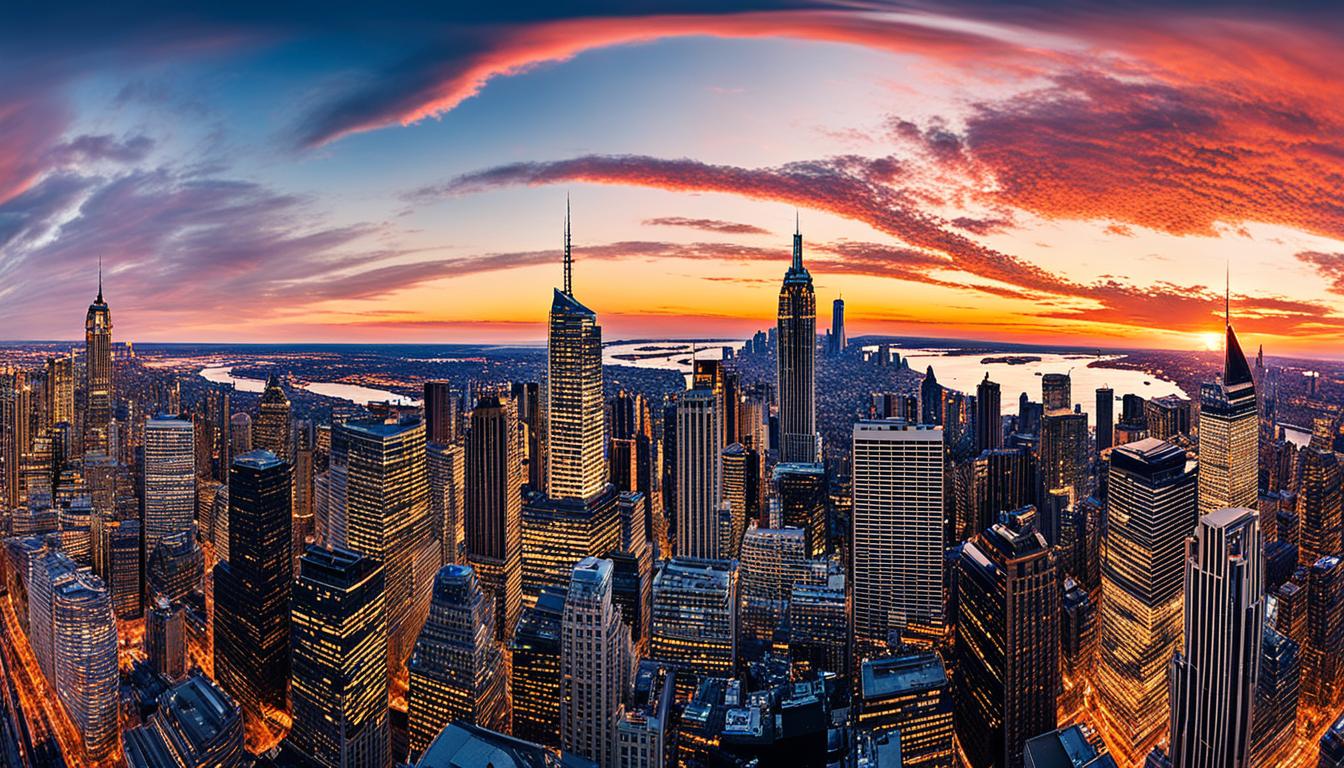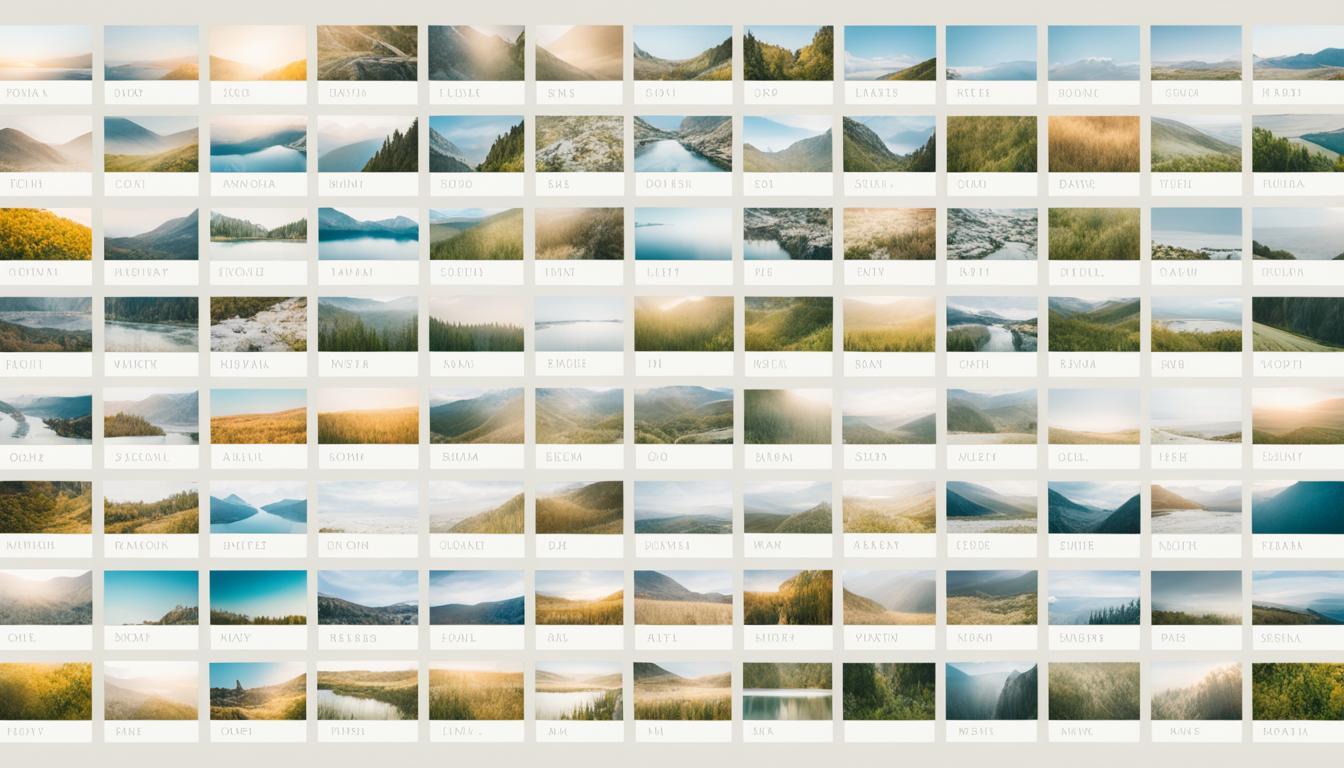Welcome to our article on panoramic stitching and editing! In this post, we will explore the fascinating world of professional image editing techniques that enable photographers to create stunning panoramic images. With the advancement of digital photo stitching and panorama enhancement services, capturing wide scenes has never been easier.
Whether you’re a landscape enthusiast, architectural photographer, or in the real estate industry, panoramic stitching and editing can take your imagery to the next level. By seamlessly blending multiple images together, you can create a single photo that captures the grandeur and beauty of expansive vistas.
Key Takeaways:
- Panoramic stitching and editing is a technique used to create seamless panoramas by blending multiple images together.
- Professional image editing software and advanced photo stitching techniques are essential for achieving high-quality panoramic edits.
- There are various techniques for creating panoramic images, including stitching, single-shot captures, and software-based panoramic stitching.
- To capture perfect panoramic shots, it’s important to consider factors such as overlap, focal length, camera level, distortion lenses, and exposure settings.
- Post-processing techniques like cropping, color correction, blending, distortion correction, and straightening can enhance the final panoramic photos.
Now, let’s dive deeper into the techniques, tips, and advantages of panoramic photography. We’ll also explore popular locations that provide breathtaking opportunities for capturing panoramic shots. Stay with us to unleash the full potential of panoramic stitching and editing!
Techniques for Creating Panoramic Images
When it comes to creating stunning panoramic images, photographers have a range of techniques at their disposal. Let’s explore three popular methods: stitching, single shot capture, and software-based panoramic stitching.
Stitching
Stitching involves capturing multiple images of a scene and then merging them together using image editing software. This technique allows photographers to create a wide-angle view by seamlessly blending the images. By carefully aligning and overlapping each shot, the software stitches them together to create a single cohesive panorama.
Single Shot Capture
For those looking to simplify the process, using a specialized panoramic camera with a wide field of view can be a great option. These cameras capture a panoramic scene in a single shot, eliminating the need for stitching. This technique is particularly useful when you want to quickly capture breathtaking landscapes or architectural marvels without the hassle of multiple images.
Software-based Panoramic Stitching
Another technique gaining popularity is software-based panoramic stitching. With this approach, photographers can create stunning panoramas from a single image. Specialized software algorithms analyze and stitch together different sections of the photo, seamlessly blending them to achieve a wide-angle view. This method is ideal for situations where capturing multiple images may not be feasible or time-consuming.
“By using techniques such as stitching, single shot capture, or software-based panoramic stitching, photographers can elevate their panoramic photography and capture breathtaking scenes with ease.”
Regardless of the technique chosen, each method offers unique advantages and flexibility. The choice will ultimately depend on the specific requirements and preferences of the photographer.
To get a better understanding, let’s compare the three techniques in the table below:
| Technique | Advantages |
|---|---|
| Stitching | 1. Provides precise control over the composition 2. Allows for capturing more details and higher resolution 3. Flexibility to adjust perspective and cropping |
| Single Shot Capture | 1. Quick and efficient method 2. Ideal for capturing fast-moving subjects 3. Simplifies the post-processing workflow |
| Software-based Panoramic Stitching | 1. Enables panoramas from a single image 2. Suitable for situations where capturing multiple images is not possible 3. Saves time and effort in the field |
Experimenting with different techniques will help photographers find their preferred method for capturing breathtaking panoramas. It’s essential to consider factors such as the desired level of control, time constraints, and the scene’s characteristics when choosing the technique to use.
Tips for Capturing Perfect Panoramic Shots
To capture the best panoramic shots, there are several tips to keep in mind. First, ensure that each image overlaps with the adjacent one by at least 20% to provide enough information for stitching. This ensures a smooth transition between images and helps create a seamless panoramic photo.
When capturing the images, it’s important to use a consistent focal length throughout the series. This helps maintain consistent proportions and perspective in the final panorama. If you change the focal length, it can result in distortions and inconsistencies in the stitched image.
Keeping the camera level is crucial for achieving accurate and error-free panoramas. Use a tripod or level the camera properly to prevent tilted or misaligned images. A level horizon makes a significant difference in the overall quality of the final result.
Another important aspect is to stay in the same position while capturing the series of images. Moving the camera or changing the shooting position can introduce parallax error, which makes it difficult to stitch the images together seamlessly. By staying in the same spot, you ensure that the perspective remains consistent throughout the panoramic sequence.
Avoid using distortion lenses when shooting panoramas, as they can cause exaggerated and irregular distortions, resulting in challenging stitching and poor image quality. Instead, opt for lenses with minimal distortion or rectilinear lenses specifically designed for panoramic photography.
Maintaining the same exposure settings across all images is essential for achieving a cohesive and well-blended panoramic photo. Inconsistent exposures can create visible seams and differences in brightness, which can be challenging to correct during the editing process.
By following these tips, you can capture perfect panoramic shots that are ready for seamless stitching and editing into stunning final images.

“Capture breathtaking vistas with panoramic photography by ensuring overlap, consistent focal length, level camera, same position, avoidance of distortion lenses, and maintaining the same exposure settings.”
Post-Processing Techniques for Panoramic Photos
Once you’ve captured the images for your panoramic photo, post-processing techniques can take your final result to the next level. By utilizing various editing tools, you can enhance the overall quality and visual appeal of your panorama. Here are some key post-processing techniques to consider:
Cropping
Cropping is an essential step in refining your panoramic image. It allows you to remove any unwanted areas that may distract from the main subject or disrupt the composition. By carefully selecting the desired portion of your panorama, you can create a more focused and visually pleasing result.
Color Correction
Color correction plays a vital role in ensuring a consistent and balanced look across all images in your panorama. By adjusting the color temperature, hue, saturation, and contrast, you can achieve a cohesive and harmonious color palette. This step is particularly important when stitching together images taken under different lighting conditions or with varying camera settings.
Blending
Blending techniques are used to seamlessly merge the stitched areas of your panorama, making them less noticeable to the viewer. By carefully blending the overlapping regions, you can create smooth transitions and eliminate any visible seams or distortions. This process requires precision and attention to detail to achieve a natural and cohesive look.
Distortion Correction
Distortion correction is crucial for achieving accurate proportions and straight lines in your panoramic image. Wide-angle lenses can often introduce barrel distortion or other distortions that can negatively impact the final result. By applying distortion correction techniques, you can minimize the distortion and ensure that your buildings, horizons, and other straight elements appear natural and undistorted.
Straightening
Straightening your panoramic image helps align horizons and vertical lines, creating a more visually pleasing and balanced composition. By carefully adjusting the rotation and tilt of your image, you can ensure that all elements within the scene appear level and in proper alignment. Straightening adds to the overall professionalism and quality of your panoramic photo.
Note: Implementing these post-processing techniques requires proficiency in image editing software, such as Adobe Photoshop or Lightroom. It’s advisable to experiment with different adjustments and seek guidance from online tutorials or photography communities to refine your post-processing skills.
By applying these post-processing techniques – cropping, color correction, blending, distortion correction, and straightening, you can enhance the visual impact and overall quality of your panoramic photos. The careful application of these techniques will result in captivating and immersive panoramic images that leave a lasting impression on viewers.
Continue reading to discover the advantages of panoramic photography and popular locations for capturing breathtaking panoramas.
Advantages of Panoramic Photography
Panoramic photography offers several advantages. The wide field of view allows us to capture entire scenes in a single image, making it especially useful for landscapes, architecture, and real estate photography. With panoramic images, we can create immersive and awe-inspiring landscapes that provide viewers with a sense of being present in the scene.
Capturing Entire Scenes
One of the key advantages of panoramic photography is the ability to capture entire scenes in a single frame. Whether it’s a breathtaking sunset on a beach, a majestic mountain range, or a sprawling cityscape, panoramas allow us to capture the full scope and grandeur of the scene. By encompassing a wider field of view, we can showcase the beauty and magnitude of the environment.
Immersive Landscapes
Panoramic images have the power to transport viewers into the heart of a landscape. With their wide perspective, these photos can evoke a strong sense of immersion, as if the viewer is standing right in the midst of the picturesque scenery. Whether it’s a serene forest, a dramatic coastal cliff, or a vast desert, panoramic images can create a captivating visual experience that draws viewers into the moment.
“Panoramic photography allows us to capture the essence of a place in its entirety, bringing a sense of awe and wonder to viewers.”
Moreover, the immersive nature of panoramic photography extends beyond landscapes. In architectural photography, panoramas can showcase the full scope and design of a building, capturing all its intricate details in a single image. Real estate photographers can also benefit from panoramic shots, as they allow potential buyers to virtually explore and experience a property without physically being there.
| Advantages of Panoramic Photography |
|---|
| Wide field of view |
| Capturing entire scenes |
| Immersive landscapes |
Popular Locations for Panoramic Photography
Panoramic photography offers endless possibilities for capturing stunning images in unique locations. From iconic landmarks to majestic landscapes, there are countless options to explore. Experimenting with architectural panoramas can result in incredible shots that showcase famous structures from a different perspective. Imagine capturing the grandeur of the Rialto Bridge in Venice or the magnificent Eiffel Tower in Paris as part of a panoramic scene.
But it’s not just architecture that lends itself to panoramic photography. Majestic landscapes are also a popular choice for panoramic shots. Picture yourself standing amidst the breathtaking Vestrahorn mountain in Iceland, capturing its imposing beauty in a single frame. Or perhaps the rugged and picturesque Scottish Highlands, where panoramic photography allows you to showcase the vastness and scenic splendor of the region.
Exploring these popular locations for panoramic photography enables you to create unique and captivating images that transport viewers to these iconic landmarks and majestic landscapes, all through the power of seamless stitching and editing techniques.

Conclusion
Panoramic stitching and editing is a powerful technique that enables photographers to create stunning and seamless panoramic images. By following proper techniques, tips, and utilizing post-processing techniques, photographers can achieve high-quality results that captivate and engage viewers.
Whether it’s capturing the vast beauty of landscapes, showcasing the intricate details of architecture, or highlighting the spaciousness of real estate, panoramic photography offers unique perspectives that immerse viewers in the scene.
Through professional image editing and advanced stitching techniques, photographers can effortlessly blend multiple images together to create panoramas that capture the beauty and grandeur of expansive scenes. The panoramic format allows for a wider field of view, enabling photographers to encapsulate entire scenes in a single image, providing a breathtaking and immersive experience for the viewer.
In summary, panoramic stitching and editing provide an incredible opportunity for photographers to unleash their creativity and produce visually captivating images. By mastering the techniques, incorporating valuable tips, and employing post-processing techniques, photographers can elevate their panoramic photography to new heights. So, go ahead, explore the world of panoramic photography, and mesmerize your audience with captivating panoramas made possible through professional image editing and advanced stitching techniques.
FAQ
What is panoramic stitching and editing?
Panoramic stitching and editing is a technique that allows photographers to blend multiple images together seamlessly to create panoramic photographs. This process is commonly used in landscape, architectural, and real estate photography to capture wide scenes in a single image.
What are the techniques for creating panoramic images?
There are several techniques for creating panoramic images. One method is stitching, where multiple images are captured and then merged together using image editing software. Another option is using a specialized panoramic camera that captures a wide field of view in a single shot. Finally, software-based panoramic stitching allows photographers to create panoramas from a single image, using specialized software to stitch and blend the photos seamlessly.
What are some tips for capturing perfect panoramic shots?
To capture the best panoramic shots, it is important to ensure that each image overlaps with the adjacent one by at least 20%. Using a consistent focal length and keeping the camera level can help avoid errors in the final panorama. Staying in the same position while capturing the series of images and avoiding distortion lenses can also contribute to better results. Lastly, maintaining the same exposure settings across all images will help with seamless blending in the editing process.
What post-processing techniques can enhance a panoramic photo?
After capturing the images for a panorama, post-processing techniques can enhance the final result. Cropping can be used to remove any unwanted areas, and color correction can ensure a consistent look across all images. Blending techniques can be applied to make the stitched areas less noticeable, while distortion correction and straightening can help create a more accurate and visually pleasing image.
What are the advantages of panoramic photography?
Panoramic photography offers several advantages. The wide field of view allows photographers to capture entire scenes in a single image, which is especially useful for landscapes, architecture, and real estate photography. Panoramas can create immersive and awe-inspiring landscapes that provide viewers with a sense of being present in the scene.
What are some popular locations for panoramic photography?
Panoramic photography can be done in various locations to capture unique and stunning images. Experimenting with architecture panoramas can result in unusual and incredible shots, such as capturing famous landmarks like the Rialto Bridge in Venice or the Eiffel Tower in Paris as part of a panoramic scene. Majestic landscapes, such as the Vestrahorn mountain in Iceland or the Scottish Highlands, are also popular choices for panoramic photography.
Is Panoramic Stitching and Editing only possible with RAW images, or can it also be done with JPEG images?
Panoramic stitching and editing can be done with both RAW and JPEG images, but there are some differences in the process. When it comes to raw vs jpeg editing variations, working with RAW images allows for more flexibility and better image quality, while JPEG images may have limited editing options due to compression.




